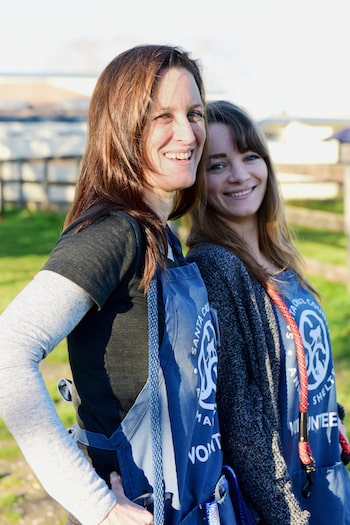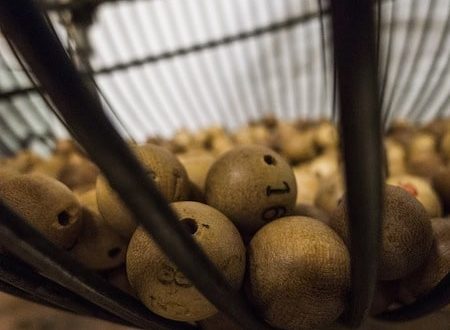
Shelter Dogs and Other Blessings
By Sheila Borgman
On a Sunday morning in May, my 14-year-old daughter Eva sulked as we drove to the Santa Cruz County Animal Shelter (SCCAS). The night before I’d told her she couldn’t go to a bonfire with older kids and she’d been giving me the silent treatment ever since.
We were headed to our weekly volunteer shift at SCCAS, something we’d been doing since Eva turned 13. Looking back on our eight years at the Shelter, I realize now that our time together went far beyond hanging out with dogs once a week. It was a way to connect during the spooky teenage years when communication is hampered by emotional landmines and slammed doors.
As soon as we arrived at the shelter, something shifted in my daughter. While gathering our supplies, Eva began to chatter about which dogs had been adopted since our last shift. We made our way to the kennels and stopped in front of a young brown-and-white Pit Bull named Hopper, who’d been dubbed “Everyday Sunshine” by the Shelter staff for his friendly, goofy demeanor.

“Do you want to try getting him out, Mom?” Eva asked.
From the start, my daughter was a better dog handler than I was. Weighing in at only 100 pounds, she was no match for most dogs size-wise; her strength came from her calm, confident demeanor.
“Sure, I’ll try,” I said, watching Hopper pogo around his enclosure. I bent to unlock his kennel, my slip-leash ready.
We retrieved him from the grooming station at the end of the hall. “This time I’ve got him for real,” I said, moving in with my leash.
We retrieved him from the toy bin by the Animal Care office. He had a stuffed squirrel in his mouth.
“Want me to get him, Mom?”
“Please.”
Open Door, Open Heart
SCCAS is an open-admission facility serving the neediest animals in Santa Cruz County. The shelter admits all domestic animals no matter how injured, sick, aggressive, or shut-down. An amazing array of creatures come through SCCAS’s doors: from dogs and cats to pigs and horses to snakes and goldfish to chinchillas and parrots. Over 5,000 animals are housed by SCCAS annually, and in the past 10 years the shelter has performed 32,332 spays and neuters, returned 11,047 animals to their owners, and facilitated 18,881 adoptions. In addition, the shelter’s outreach services provide free and low-cost spay and neuter procedures, vaccinations, pet supplies, and more. The Extra Mile program, funded by private donations, allows severely sick or injured animals to receive advanced medical care, and after-school programs and summer Critter Camp help educate kids about animal welfare in fun, interactive ways.
Staff provides extensive training and support to the hundreds of volunteers who care for the animals onsite and through the Shelter’s foster program. Eva and I have never been injured while at the Shelter, unless you count the time she drilled me in the stomach with a tennis ball hurled from a Chuckit.
The Hopper Effect
On that Sunday morning in May, Eva and I spent a long time with Hopper. He played fetch, sat for treats, and rolled over for belly rubs. After several weeks at the Shelter, including a week with us in foster, he was adopted by a nice woman and her young daughter. She contacted me soon after to report that everyone loved him—even the cat.
Eva and I still do our Sunday shifts whenever she’s home from college. She’s now 21 and an Animal Sciences major at Cal Poly, where she’s taking the prerequisites for vet school. Her shelter experience gave her a boost during the hectic admissions process and helped her land a great internship with a local vet.
While the endless tide of homeless animals coming through SCCAS’s doors can take an emotional toll on those who care for them, success stories prevail. I wouldn’t trade my shelter time with Eva for anything, and I imagine she’d say the same. Not only did we get to know multitudes of dogs over the years, we got to know each other. And that’s definitely worth a Chuckit to the stomach.
For more information about volunteering at SCCAS—either onsite or as a foster home—visit https://www.scanimalshelter.org/become_a_volunteer/. Children can start working onsite with the animals at age twelve with an adult guardian who has also completed training. The website also has more information about camp and afterschool programs for kids.
Sheila Borgman is a science editor and writer. She lives in Capitola with her human and furry/feathered family.


You May Also Like

How to Get Back in the Saddle and Get Fired Up for Longer Rides
July 1, 2019
Families Grow Healthy with WIC: Birth Matters July 2019
July 1, 2019

